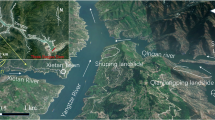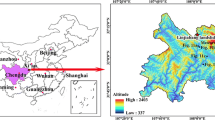Abstract
How to reduce landslide risk economically and effectively is a very meaningful and challenging research topic. In particular, it is difficult and expensive to completely control deep-seated colluvial landslides. Taking the Kangjiapo landslide in Wanzhou district, Chongqing city, China, as a case, this study focuses on measures to prevent and control the risks of deep-seated colluvial landslides through detailed investigation and monitoring. The Kangjiapo landslide is located in the Three Gorges Reservoir area, and it is part of a famous ancient landslide named the Pipaping landslide. The steep sliding surface in the rear was not found during the first treatment; the Kangjiapo landslide has been reactivated since 2015. Field investigations, monitoring, borehole, and related tests were conducted to identify the landslide characteristics and mechanisms. The landslide deformation was not spatially or temporally uniform according to monitoring data analysis. The landslide is less likely to fail in general because the sliding surface in the front is very gentle. The reasons for Kangjiapo landslide reactivation could include the decline of the reservoir water level, a steep sliding surface in the rear, and the existence of a sliding zone with low strength due to a long period of reservoir immersion. In order to reduce the deep-seated landslide risk, landslide mitigation measures including stabilizing piles nearby the road, BeiDou Navigation Satellite System, and MEMS inclinometer in the platform are proposed. This landslide control practice provides a new idea for the deep-seated colluvial landslides.















Similar content being viewed by others
Data availability
The data used to support the findings of this study are available from the authors upon request.
References
Brückl E, Brunner FK, Kraus K (2006) Kinematics of a deep-seated landslide derived from photogrammetric, GPS and geophysical data engineering. Geology 88(3–4):149–159. https://doi.org/10.1016/j.enggeo.2006.09.004
Chen M, Lv P, Zhang S, Chen X, Zhou J (2018) Time evolution and spatial accumulation of progressive failure for Xinhua slope in the Dagangshan reservoir, Southwest China. Landslides 15:565–580. https://doi.org/10.1007/s10346-018-0946-8
Cojean R (2015) The 2014 Hans Cloos lecture: engineering geology, some feedback regarding the practice of a scientific and technical discipline. Bull Eng Geol Env 74:1087–1103. https://doi.org/10.1007/s10064-015-0768-z
Cojean R, Cai YJ (2011) Analysis and modeling of slope stability in the Three-Gorges Dam reservoir (China) – the case of Huangtupo landside. J Mt Sci 8(2):166–175. https://doi.org/10.1007/s11629-011-2100-0
Glenn NF, Streutker DR, Chadwick DJ, Thackray GD, Dorsch SJ (2006) Analysis of LiDAR-derived topographic information for characterizing and differentiating landslide morphology and activity. Geomorphology 73:131–148. https://doi.org/10.1016/j.geomorph.2005.07.006
Gui L, Yin K, Glade T (2016) Landslide displacement analysis based on fractal theory, in Wanzhou District, Three Gorges Reservoir, China. Geomat Nat Haz Risk 7(5):1707–1725. https://doi.org/10.1080/19475705.2015.1137241
Hendron AJ, Patton FD (1987) The Vaiont slide - a geotechnical analysis based on new geologic observations of the failure surface. Eng Geol 24:475–491. https://doi.org/10.1016/0013-7952(87)90080-9
Hewitt K, Clague JJ, Orwin JF (2008) Legacies of catastrophic rock slope failures in mountain landscapes. Earth Sci Rev 87(1–2):1–38. https://doi.org/10.1016/j.earscirev.2007.10.002
Hou X, Li T, Qi S, Guo S, Li P, Xi Y, Xing X (2021) Investigation of the cumulative influence of infiltration on the slope stability with a thick unsaturated zone. Bull Eng Geol Env 80(7):5467–5480. https://doi.org/10.1007/s10064-021-02287-2
Huang R (2012) Mechanisms of large-scale landslides in China. Bull Eng Geol Env 71(1):161–170. https://doi.org/10.1007/s10064-011-0403-6
Kang X, Wang S, Wu W, Xu G, Zhao J, Liu F (2022) Soil-water interaction affecting a deep-seated landslide: from field monitoring to experimental analysis. Bull Eng Geol Env 81(2):82. https://doi.org/10.1007/s10064-021-02556-0
Kasai M, Ikeda M, Asahina T, Fujisawa K (2009) LiDAR-derived DEM evaluation of deep-seated landslides in a steep and rocky region of Japan. Geomorphology 113(1–2):57–69. https://doi.org/10.1016/j.geomorph.2009.06.004
Kaunda R (2010) A linear regression framework for predicting subsurface geometries and displacement rates in deep-seated, slow-moving landslides. Eng Geol 114:1–9. https://doi.org/10.1016/j.enggeo.2010.03.004
Li D, Yan L, Wu L, Yin K, Leo C (2019) The Hejiapingzi landslide in Weining County, Guizhou Province, Southwest China: a recent slow-moving landslide triggered by reservoir drawdown. Landslides 16:1353–1365. https://doi.org/10.1007/s10346-019-01189-5
Li D, Yin K, Leo C (2010) Analysis of Baishuihe landslide influenced by the effects of reservoir water and rainfall. Environ Earth Sci 60:677–687. https://doi.org/10.1007/s12665-009-0206-2
Lo CM (2017) Evolution of deep-seated landslide at Putanpunas stream, Taiwan. Geomat Nat Haz Risk 8(2):1204–1224. https://doi.org/10.1080/19475705.2017.1309462
Mebrahtu TK, Hussien B, Banning A, Wohnlich S (2022) Predisposing and triggering factors of large-scale landslides in Debre Sina area, central Ethiopian highlands. Bull Eng Geol Environ 80(1):365–383. https://doi.org/10.1007/s10064-020-01961-1
Miao F, Zhao F, Wu Y, Li L, Török Á (2023) Landslide susceptibility mapping in Three Gorges Reservoir area based on GIS and boosting decision tree model. Stochastic Environ Res Risk Assess. https://doi.org/10.1007/s00477-023-02394-4
Miao F, Zhao F, Wu Y, Li L, Xue Y, Meng J (2022) A novel seepage device and ring-shear test on slip zone soils of landslide in the Three Gorges Reservoir area. Eng Geol 307:106779. https://doi.org/10.1016/j.enggeo.2022.106779
Paronuzzi P, Rigo E, Bolla A (2013) Influence of filling-drawdown cycles of the Vajont reservoir on MT. Toc slope stability. Geomorphology 191(5):75–93. https://doi.org/10.1016/j.geomorph.2013.03.004
Schulz W (2007) Landslide susceptibility revealed by LIDAR imagery and historical records, Seattle, Washington. Eng Geol 89:67–87. https://doi.org/10.1016/j.enggeo.2006.09.019
Tang H, Wasowski J, Juang C (2019) Geohazards in the three Gorges Reservoir Area China–lessons learned from decades of research. Eng GeOl 261:105267. https://doi.org/10.1016/j.enggeo.2019.105267
Van Asch TWJ, Hendriks MR, Hessel R, Rappange FE (1996) Hydrological triggering conditions of landslides in varved clays in the French Alps. Eng Geol 42(4):239–251. https://doi.org/10.1016/0013-7952(95)00082-8
Van Den Eeckhaut M, Poesen J, Verstraeten G, Vanacker V, Moeyersons J, Nyssen J, van Beek LPH (2005) The effectiveness of hillshade maps and expert knowledge in mapping old deep-seated landslides. Geomorphology 670(3–4):351–363. https://doi.org/10.1016/j.geomorph.2004.11.001
Acknowledgements
The authors would like to thank Jiang Wu, Yingchun Li, and Qingli Liu from Wanzhou Station of Geo-Environment Monitoring for providing the landslide material.
Funding
This study was financially supported by The Natural Science Foundation of China (41772310, 42007267).
Author information
Authors and Affiliations
Contributions
Xiaoxu Xie contributed to the investigation, data curation, calculation, drawing, and writing—original draft. Deying Li contributed to the methodology, writing—review and editing, and funding. Fasheng Miao contributed to the writing—review and editing and funding. Liangxuan Yan contributed to the investigation, data curation, and calculation. Chin Leo contributed to the writing—review and editing. Yiqing Sun contributed to the investigation and drawing.
Corresponding author
Ethics declarations
Consent for publication
The authors declare the work described is original research that has not been published previously.
Conflict of interest
The authors declare no competing interests.
Rights and permissions
Springer Nature or its licensor (e.g. a society or other partner) holds exclusive rights to this article under a publishing agreement with the author(s) or other rightsholder(s); author self-archiving of the accepted manuscript version of this article is solely governed by the terms of such publishing agreement and applicable law.
About this article
Cite this article
Xie, X., Li, D., Miao, F. et al. The Kangjiapo landslide in Wanzhou district, Chongqing city: reactivation of a deep-seated colluvial landslide in the Three Gorges Reservoir. Bull Eng Geol Environ 82, 386 (2023). https://doi.org/10.1007/s10064-023-03404-z
Received:
Accepted:
Published:
DOI: https://doi.org/10.1007/s10064-023-03404-z




